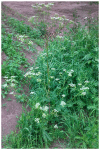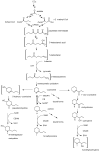The killer of Socrates: Coniine and Related Alkaloids in the Plant Kingdom
- PMID: 29135964
- PMCID: PMC6150177
- DOI: 10.3390/molecules22111962
The killer of Socrates: Coniine and Related Alkaloids in the Plant Kingdom
Abstract
Coniine, a polyketide-derived alkaloid, is poisonous to humans and animals. It is a nicotinic acetylcholine receptor antagonist, which leads to inhibition of the nervous system, eventually causing death by suffocation in mammals. Coniine's most famous victim is Socrates who was sentenced to death by poison chalice containing poison hemlock in 399 BC. In chemistry, coniine holds two historical records: It is the first alkaloid the chemical structure of which was established (in 1881), and that was chemically synthesized (in 1886). In plants, coniine and twelve closely related alkaloids are known from poison hemlock (Conium maculatum L.), and several Sarracenia and Aloe species. Recent work confirmed its biosynthetic polyketide origin. Biosynthesis commences by carbon backbone formation from butyryl-CoA and two malonyl-CoA building blocks catalyzed by polyketide synthase. A transamination reaction incorporates nitrogen from l-alanine and non-enzymatic cyclization leads to γ-coniceine, the first hemlock alkaloid in the pathway. Ultimately, reduction of γ-coniceine to coniine is facilitated by NADPH-dependent γ-coniceine reductase. Although coniine is notorious for its toxicity, there is no consensus on its ecological roles, especially in the carnivorous pitcher plants where it occurs. Lately there has been renewed interest in coniine's medical uses particularly for pain relief without an addictive side effect.
Keywords: Aloe; Sarracenia; Socrates; alkaloids; coniine; poison hemlock (Conium maculatum L.); polyketides; secondary metabolism.
Conflict of interest statement
The authors declare no conflict of interest. The founding sponsors had no role in the writing of the manuscript.
Figures







Similar articles
-
Polyketide synthases from poison hemlock (Conium maculatum L.).FEBS J. 2015 Nov;282(21):4141-56. doi: 10.1111/febs.13410. Epub 2015 Sep 11. FEBS J. 2015. PMID: 26260860
-
Hemlock alkaloids from Socrates to poison aloes.Phytochemistry. 2005 Jun;66(12):1399-1406. doi: 10.1016/j.phytochem.2005.04.039. Phytochemistry. 2005. PMID: 15955542 Review.
-
A novel toxic alkaloid from poison hemlock (Conium maculatum L., Apiaceae): identification, synthesis and antinociceptive activity.Food Chem Toxicol. 2012 Feb;50(2):274-9. doi: 10.1016/j.fct.2011.10.060. Epub 2011 Oct 30. Food Chem Toxicol. 2012. PMID: 22063758
-
Stereoselective potencies and relative toxicities of coniine enantiomers.Chem Res Toxicol. 2008 Oct;21(10):2061-4. doi: 10.1021/tx800229w. Epub 2008 Sep 3. Chem Res Toxicol. 2008. PMID: 18763813
-
Biochemistry of hemlock (Conium maculatum L.) alkaloids and their acute and chronic toxicity in livestock. A review.Toxicon. 1999 Jun;37(6):841-65. doi: 10.1016/s0041-0101(98)00204-9. Toxicon. 1999. PMID: 10340826 Review.
Cited by
-
Secondary Metabolites with Biomedical Applications from Plants of the Sarraceniaceae Family.Int J Mol Sci. 2022 Aug 30;23(17):9877. doi: 10.3390/ijms23179877. Int J Mol Sci. 2022. PMID: 36077275 Free PMC article. Review.
-
Turning Meadow Weeds Into Valuable Species for the Romanian Ethnomedicine While Complying With the Environmentally Friendly Farming Requirements of the European Union's Common Agricultural Policy.Front Pharmacol. 2020 Apr 23;11:529. doi: 10.3389/fphar.2020.00529. eCollection 2020. Front Pharmacol. 2020. PMID: 32390852 Free PMC article. Review.
-
Metabolic consequences of various fruit-based diets in a generalist insect species.Elife. 2023 Jun 6;12:e84370. doi: 10.7554/eLife.84370. Elife. 2023. PMID: 37278030 Free PMC article.
-
Phytochemical profiling of antimicrobial and potential antioxidant plant: Nepeta cataria.Front Plant Sci. 2022 Sep 26;13:969316. doi: 10.3389/fpls.2022.969316. eCollection 2022. Front Plant Sci. 2022. PMID: 36226301 Free PMC article.
-
Ligand-modulated nickel-catalyzed regioselective silylalkylation of alkenes.Nat Commun. 2023 Nov 23;14(1):7670. doi: 10.1038/s41467-023-43642-z. Nat Commun. 2023. PMID: 37996492 Free PMC article.
References
-
- Hotti H., Häkkinen S.T., Seppänen-Laakso T., Rischer H. Polyketide-derived alkaloids and anthraquinones in Aloe plants and cell cultures. 2017. Unpublished work.
Publication types
MeSH terms
Substances
LinkOut - more resources
Full Text Sources
Other Literature Sources

